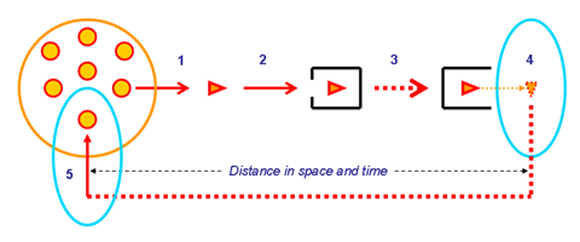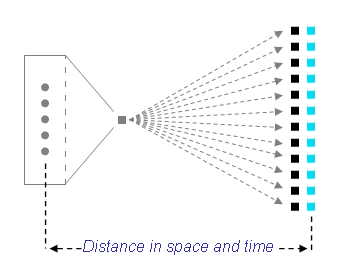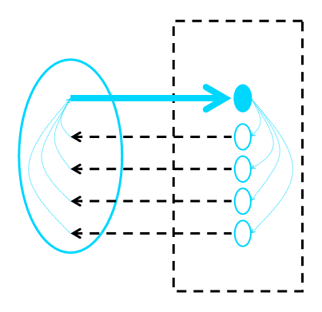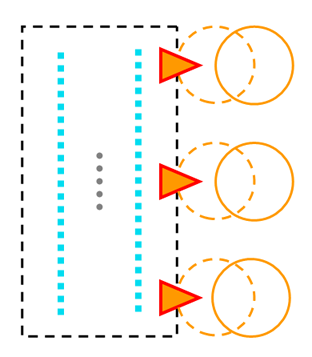08 | Groundwork | Four Observations: Proximity
December 27th, 2011 by bruno boutotNote: The five posts entitled “Groundwork” were originally written in 2009. See here.
. #
The Internet is a place. It is a weird place in which proximity is determined by interest, rather than a space in which interests are kept apart by distances. It is a place in which nearness defeats distance.Let’s begin with a process we know very well: Advertising. #
David Weinberger
The Net is a place #
The orange balls represent the product we want to promote, followed by what the ad must do. #
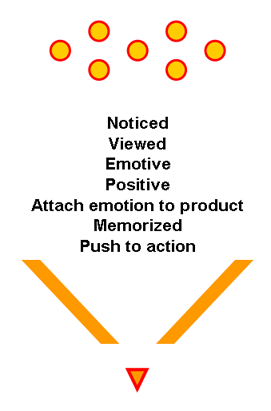
figure 10: The advertising process #
Observations on figure 10 #
As a communication specialist, I admire the work of the ad agencies’ creative minds.
They have to pack a lot of information into a very small area, like a printed page or a 30-second TV or radio commercial.
Given a product (the circles), they have to make an ad (the triangle) that accomplishes numerous tasks: #
- First it must be noticed among the clutter of thousands of ads that we see every day.
- Then it must keep our attention to make sure that we read or view the whole message.
- It must summon an emotion, because emotions are the only paths to memory.
- This emotion must be positive enough to engage us.
- This positive emotion must be attached to the product.
- This product-emotion must be anchored in the viewer’s memory.
- And then, tightly packaged with all this, there must be some kind of spring that will unwind at just the right moment: a delayed push to action.
figure 11: Traditional marketing #
Observations on figure 11 #
Recap: (1) An advertiser orders an ad from an agency; (2) the agency buys a place for the ad in the media; (3) the media is sent out to the consumer. #
(4) The ad is viewed where the media reaches the consumer, which is generally at work, at home, or in transport. The consumer comes in contact with the ad and then, hopefully, the ad leaves behind an imprint (the dotted triangle) on the consumer’s memory. #
(5) For the ad to succeed, the consumer must, later, go to a store in person to buy the product. #
“later”: The time between the placement of an ad and the act of buying a product can be as brief as one hour. But generally it takes days, weeks, even months, and sometimes years. #
“store”: The distance between the place where the consumer views the media and the store can be as near as 100 m and as far as 10 km or more. #
A good ad is first an imprint device and then
it’s a vehicle to make a buying decision travel through space and time. #
Note: figure 12 will appear in a future edition. Here we jump directly to figure 13.
#
figure 13: The traditional content process #
Observations on figure 13 #
For users of a traditional mass media only they themselves (the blue squares) and the media products (the black squares) are in physical contact – the black squares represent either a paper object (print) or a receiving device (radio or TV). #
The media makers (the gray dots) and the making of the product (the gray square) are far away from users in space and in time. #
figure 14: The Web media content process #
Observations on figure 14 #
For users (the blue squares) of a Web media, their attention (the blue dots) is inside the media site (the black-dashed rectangle). #
Here, they feel as though they are in immediate proximity of other users and of the media makers. #
The media makers (the gray dots) are hiding behind their content (small black dashes): they imagine that they can maintain their distance from the users as in a traditional media. But users know now from countless other sites that this distance doesn’t really exist. In every news media on the Web where readers can’t interact with journalists, readers know that it is only so because journalists (or editors or publishers) don’t want them to. #
figure 15: Proximity is only in the hands of the users
#
Observations on figure 15 #
On the Web, proximity is only available to a person, never to a media. #
Media makers, as individuals, can reach any Web page a click away, but the media website itself can’t be sent away on a decision from the media. #
A media website doesn’t move, can’t move, and can’t be sent to consumers: it sits on a server. #
We have to learn immobility. #
It is the decision of the users to take their attention to the media (the blue solid horizontal arrow).
For any content that can interest the users (news alerts, new comments, images, offers, activities, etc.) the media can (and should) offer to the users as many ways as possible to be alerted (the black-dashed arrows): #
- RSS
- email,
- Twitter, etc.
It is important to understand that these alerts are not a return to the traditional media process of sending content. The only function of these alerts is to bring the users back to our place where we can use all the advantages of proximity. #
figure 16: What proximity changes #
Observations on figure 16 #
The black dashes represent the news media on the Web.
Users (the blue squares) are inside the website.
The triangles represent the ads that send our users to the merchants (the orange line circles). #
Marketing: #
Proximity kills the distance in space and time between media and merchant: the orange circles become orange-dashed circles.
Proximity can fuse advertiser and merchant (the ads are a part of the dashed circles) inside the media.
Proximity can bring users and merchants in contact inside the media.
For users and merchants who are inside the media (member users and member merchants) once an ad has been clicked on, marketing may end: the media can become a place for sales. #
Content: #
Proximity kills the distance in space and time between the media makers and the readers.
Readers are among us, right there, we can touch them.
Everybody is a click away: everything can be personal whenever the “personal” is more efficient or more productive than generic content or an automatic process. #
